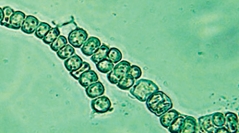

 Cryptogamie, Algologie
45 (4) - Pages 39-51
Cryptogamie, Algologie
45 (4) - Pages 39-51To increase the knowledge on diversity of freshwater cyanobacteria, we have characterized a novel filamentous, benthic cyanobacterium isolated from a pond in Golestan province, Iran. The isolate was studied using a polyphasic approach based on morphological and molecular characteristics, including phylogenetic and structural analysis of the 16S rRNA gene sequence and 16S to 23S internal transcribed spacer (ITS), respectively. The overall morphology of the isolate was similar to Nostocalean member’s strains with non-tapering filaments and distributed heterocytes. However, the molecular analyses suggested that it was more closely related to the lithobiont and rock-dwelling Goleter apudmare Miscoe & J.R.Johansen, which has tapered filaments and basal heterocytes. The 16S rRNA gene phylogenetic analysis, based on bayesian inference and maximum likelihood methods, placed the isolate close to G. apudmare. The D1-D1’, Box-B and V3 helixes of the isolate’s ITS sequence were different when compared to other Goleter ITS sequences. Similar to G. apudmare HA4356-MV2 (JN385288.1) and Goleter sp. CHAB TP201702 (MT488126.1), tRNA genes were absent from the amplified ITS sequence in the studied isolate. These morphological and molecular characteristics differentiate this isolate from all other Goleter taxa described so far, which contributes to extend the knowledge on cyanobacterial diversity and occurrence of benthic cyanobacteria in Iranian freshwaters.
Cyanobacteria, Nostocales, freshwater, temperate climate, polyphasic approach